| Author |
Message |
|
Scott Woodruff
|
 Posted: Mon 20 Aug, 2012 3:11 pm Post subject: Looking for more info on Hjortspring swords Posted: Mon 20 Aug, 2012 3:11 pm Post subject: Looking for more info on Hjortspring swords |
 |
|
|
I have been able to find only one picture of the Hjortspring swords and very little written information. I would love to hear from anyone who has seen them in person. I especially want to find out about the bolster construction. Is it solid, a piece of welded tubing or a simple band nailed on or riveted closed. Are the bolsters iron or copper alloy? Also, I would love to find some measurement information, especially widths and thicknesses. Any help would be greatly appreciated. http://www.hjortspring.dk/wold/swords.htm http://forums.dfoggknives.com/index.php?showtopic=14821
|
|
  |
 |
|
Scott Woodruff
|
 Posted: Sat 25 Aug, 2012 7:16 am Post subject: Posted: Sat 25 Aug, 2012 7:16 am Post subject: |
 |
|
|
Last night I began forging my Hjortspring type 1 blade. The spine is about 8mm thick and after it has been "T-backed" should reach at least 9mm. As I have been able to find no further info, I am just going to have to wing it. I am goin to try to have a flat bevel with a tight radius right at the T-back and a simple iron band, though I haven't decided yet if I will forge it from tubing or just nail a strip around the haft.
|
|
  |
 |
|
Tyler Keich
Location: San Diego, CA Joined: 16 Sep 2010
Posts: 32
|
 Posted: Sat 25 Aug, 2012 1:17 pm Post subject: Posted: Sat 25 Aug, 2012 1:17 pm Post subject: |
 |
|
|
Sorry that I have no information to help, but I was wondering if you could post pictures of the progression of the making of it? Thank you!
|
|
  |
 |
|
Scott Woodruff
|
 Posted: Sat 25 Aug, 2012 2:44 pm Post subject: Posted: Sat 25 Aug, 2012 2:44 pm Post subject: |
 |
|
|
In the past I have been terrible about promising pics and not delivering, but I have access to a camera now, so I will post pics soon.
|
|
  |
 |
Paul Hansen

|
 Posted: Sun 26 Aug, 2012 12:42 am Post subject: Posted: Sun 26 Aug, 2012 12:42 am Post subject: |
 |
|
Here´s what I have from the National museum in Copenhagen.
Not the greatest pics, I´m afraid...
 Attachment: 217.44 KB Attachment: 217.44 KB
[ Download ]
 Attachment: 180.31 KB Attachment: 180.31 KB
[ Download ]
|
|
  |
 |
|
Scott Woodruff
|
 Posted: Sun 26 Aug, 2012 1:55 am Post subject: Posted: Sun 26 Aug, 2012 1:55 am Post subject: |
 |
|
|
Thank you soooo much Paul, that makes a world of difference. Now I have a much better idea of cross-sectional geometry and can estimate thickness. I can now see that the reinforcing band has the typical seax teardrop section and appears to be forged from welded tubes. Now I feel like I am on much more solid ground to proceed.
|
|
  |
 |
|
Peter Johnsson
Industry Professional
|
 Posted: Sun 26 Aug, 2012 5:27 am Post subject: Posted: Sun 26 Aug, 2012 5:27 am Post subject: |
 |
|
Scott, the reinforcing bands are copper alloy that is simply wrapped around the end of the grip and secured by one or two copper alloy nails or tacks. The bands are decorated with lines, so they appear striped. The cross section of the grips towards the blade is clearly angular and follows the dimensions of the blade closely. It s less a tear drop section. More a truncated wedge. The blade width at the base can be estimated to about 2.5 cm, and the thickness of the T-back is 0.9 cm or thereabouts. It is not a continuous radius, just like you assumed, but a radius along or under the T-back that transitions into a flatter cross section towards the edge. The edges were thin on these swords. The sharpness would probably have been formed on less than a millimeter thickness. They are not far from filet knives in the edges.
-Think filet knife combined with a bayonet...
I have not done a hands on documentation of any of these, but I have studied them in their displays many times. I write this from memory and from how they are described in the original dig report.
Personally I am fascinate by the swords from the Hjortspring find. I look forward to see what you make of this!
|
|
   |
 |
|
Scott Woodruff
|
 Posted: Sun 26 Aug, 2012 7:16 am Post subject: Posted: Sun 26 Aug, 2012 7:16 am Post subject: |
 |
|
Thank you Peter, I had hoped that you would chime in. I am really glad that the bands are simply nailed on, that makes construction much easier. I am not sure how to go about shaping the blades cross section. The piece of material I am currently working on is cut from a large truck spring. I will try to forge it really close to shape so that I can do the final shaping with just an appropriately shaped block of wood and some sand paper. If I have too much trouble doing that, I may just forge as close as I can from mild steel or preferably wrought iron and shape it with a scraper. I am sure there are no metallurgical analysis of the Hjortspring swords, but I am willing to bet that they are made of wrought iron or at best an inconsistently carburized steel, and the section would give maximum stiffness even with a fairly soft material. I think I am inspired to put aside all my other projects and concentrate on this one until it is done.
Last edited by Scott Woodruff on Mon 27 Aug, 2012 4:10 am; edited 1 time in total
|
|
  |
 |
|
Scott Woodruff
|
 Posted: Sun 26 Aug, 2012 3:03 pm Post subject: Posted: Sun 26 Aug, 2012 3:03 pm Post subject: |
 |
|
|
I have a few more questions Peter, if you can. Where do the reinforcing bands overlap, the middle of one side, or midline top or bottom? Do you think that the bronze pommel-knob was flush with the end of the grip, or larger or smaller? Do you think it is likely that the ash-wood scabbards were lined with fur and what sort of suspension do you imagine they used? Maybe two offset rings like on some La Tene swords and later asymmetric-tang Germanic single-edged swords? Even if you don't have hard answers, I would really value your opinion. I would love to hear anyone elses ideas and opinions too, and of course facts and hard evidence are always appreciated.
|
|
  |
 |
|
Peter Johnsson
Industry Professional
|
 Posted: Sun 26 Aug, 2012 3:09 pm Post subject: Posted: Sun 26 Aug, 2012 3:09 pm Post subject: |
 |
|
I suspect there was a fair degree of cold forging done on these (and scraping most probably). It looks like the T-back could have been gradually formed over a tool that gives the radius and then the edge drawn out/thinned down also by cold working.
This a guess as much as anything else. Battle knives from Illerup-ådal were wrought iron, while the smaller utility knives were of steel that was heat treated. Perhaps this is a tradition that goes back to earlier times?
Perhaps phosphoric iron was used in the edges of these knives?
In the Hjortspring find there were remains of many mail shirts. An astonishing detail really, as it is one of the really early finds of this kind of armour. A bit surprising since the "swords" , spears and shields at first look seems primitive (I think they are not really that primitive, just different from later period weapons that we are used to seeing).
|
|
   |
 |
|
Peter Johnsson
Industry Professional
|
 Posted: Sun 26 Aug, 2012 3:11 pm Post subject: Posted: Sun 26 Aug, 2012 3:11 pm Post subject: |
 |
|
| Scott Woodruff wrote: | | I have a few more questions Peter, if you can. Where do the reinforcing bands overlap, the middle of one side, or midline top or bottom? Do you think that the bronze pommel-knob was flush with the end of the grip, or larger or smaller? Do you think it is likely that the ash-wood scabbards were lined with fur and what sort of suspension do you imagine they used? Maybe two offset rings like on some La Tene swords and later asymmetric-tang Germanic single-edged swords? Even if you don't have hard answers, I would really value your opinion. I would love to hear anyone elses ideas and opinions too, and of course facts and hard evidence are always appreciated. |
I´ll get back to this tomorrow: it is late here. I shall go back to the book about the find and refresh my memory. Will write again in a few hours.
:-)
|
|
   |
 |
|
Scott Woodruff
|
 Posted: Sun 26 Aug, 2012 4:48 pm Post subject: Posted: Sun 26 Aug, 2012 4:48 pm Post subject: |
 |
|
Ah, I find that bit about cold forging to be very interesting, perhaps I was on the right track considering using mild steel or wrought iron. I have often wondered if 10th-11th century Baltic wappenkniver followed this same tendency to use wrought iron for large weapons that will only see occasional use and reserve steel for use in small tools that will see constant use. I am currently looking for wrought iron, I would gladly pay ten times as much for it as for tool steel.
I agree with you that there is nothing primitive about these weapons. It seems to me that perhaps mail was more common and of higher quality in the first couple centuries after it's invention and that the Hjortspring weapons were designed to combat this extensive use of good mail. Perhaps the decline in use and quality of mail encouraged the evolution of the later more cut-oriented Germanic single-edged swords.
I have read that there was a steady decline in affluence in Scandinavia from the "Scandinavian Golden Age" (during the bronze age and first few centuries of the iron age) culminating in the catastrophic events of the mid-6th century AD, which included a massive volcanic eruption resulting in a year of winter and several years of severe climate change and disruption of agriculture and a massive pandemic, of which the plague of Justinian was a part. Apparently it took Scandinavia several centuries to recover. The Viking age with its massive influx of wealth and reestablishment of trade was instrumental in this recovery. It has been suggested that the 6th century disaster was the inspiration for the Ragnarok myth. Sorry to ramble, I just find all this stuff really fascinating.
Last edited by Scott Woodruff on Tue 28 Aug, 2012 7:12 pm; edited 1 time in total
|
|
  |
 |
|
Peter Johnsson
Industry Professional
|
 Posted: Mon 27 Aug, 2012 1:07 am Post subject: Posted: Mon 27 Aug, 2012 1:07 am Post subject: |
 |
|
So, some more data...
G Rosenberg classifies the swords in three groups. One of the groups stand out since the blades are pretty advanced in their form: long and narrow with very wide reinforcing backs and dramatic T-shaped cross section. This is the group that you, Scott, is interesting in making a practical study of.
This is the a-group and consists of blades with concave edge bevels, broad back and tang without rivets (that pass all the way through the grip and is riveted over an end cap).
These are the long (blade seems to have been just shy of 60 cm long and tang about 13-13.5 cm long), and narrow (about 2.5 cm wide and 0.9 cm thick at the back), "bayonet-like" swords.
Tang was riveted over an end cap of (cast) bronze that was round and held to the grip with "teeth" that griped over the edge of the grip (2.5 cm diameter in this case) or two integral nails (end cap 1.2 cm diameter in this case). These bronze caps show the grip end was narrow and (very close to) circular in section towards the rivet end of the grip.
The reinforcing band of the blade end of the grip is a strip of bronze with decorative groves, that is folded over the grip and secured with a small nail. The band is 1.5 cm across and shows that the grip was 2.5 cm wide (a dimension that was closely matched by the width of the blade. The bands overlap on the edge side of the grip and the nail is placed slightly to the side. The bands follow the form of the cross section of the grip: a truncated wedge shape that was very close to the dimensions of the blade. The impression would have been that the forms of grip and blade flowed into one another.
There are no remains of the grips themselves. They would have been of some kind of organic material.
As the majority of objects that are preserved in the Hjortspring find are of wood, it seems reasonable to assume the grips were made from another material than wood. Bone or horn perhaps? There are preserved sharpened antler spear heads, so antler grips would probably also have survived.
We are left to guess the form of the grips. It seems reasonable to think they were rather simple in form, but they could possible have had carved risers or some other type of decoration. There is no decorative elements surviving on spear shafts, shields, or metal blades in the find. My personal guess is that the shields were once covered with thin leather that was glued on (now disappeared without trace) Experiments with later period shields from Danish bog finds show that the thin round shields (some are found with remains of color or the boards) were covered with gut leather that greatly increased their resiliency and ability to withstand arrows without splitting.
In the Hjortspring find there are some wooden containers that are very sculptural in form. We do not know what they once contained or how they are related to the boat or its crew in function. They do show how decorative carving of the period did look like. A bone or horn grip on these war knives could perhaps be carved in a similar way? This could increase the ergonomics of the weapon and would add to visual appeal. -This is my personal guess.
One of the swords from another group had bands of bronze across the grip in intervals. Perhaps this is a feature that was carved integrally in the bone of other sword grips?
Some fragments of scabbards also remain. One of the good fragment that are preserved that goes with one of the "bayonet" swords. it is made in two halves of thin wood (0.2 - 0.5 cm thick) that is cut to shape to fit the cross section of the blade. There is a thickening along the one side of the scabbard to allow for the wide back of the sword. A few notches cut in the wood suggest that there once reinforcing bands of some kind, holding the two halves of the scabbard together. My personal guess is that there were leather thongs under a covering layer of leather. No traces of scabbard lining of any kind. -But the find does not have any remains of leather or textile, what so ever so they might have had fleece or wool lining originally. I have not been able to document any of these swords so I have not been able to see exactly what kind of fit there is between the wood and the blade. It seems to be a very tight fit between blade and scabbard core so any lining would have had to be thin.
As to suspension, we are left to guess. Perhaps a carry over from some late bronze age scabbards, using a baldric of some kind? The (leather?) bands that reinforced and held together the scabbard could have been formed into a pair of loops on one side, protruding through the layer of covering leather. Into these loops attachment to the belt or to a baldric is possible. I have seen just such a construction on a surviving bronze age scabbard, complete with inside lining, wood core and leather cover.
Such a construction would carry over from bronze age scabbards to the scabbards of the later single edged germanic war knives that survive with wood scabbards and reinforcing iron bands and carrying rings.
EDIT: Sorry, I was sloppy in my reading! There are some swords that have remains of wood, or traces of wood in the rust of the tangs, so wood grip cannot be ruled out and may in fact be a very probable design solution. (Perhaps wood covered in thin gut leather?)
EDIT AGAIN: Corrected measurement of bronze band: 1.5 CM x 2.5 cm.
Also make note of how slim and graceful these long blades were, despite (or together with) their thick back: the surviving thickness along the mid line of the blade (halfway between reinforced back and the edge) is only 0.25 - 0.3 millimeter! These are dimensions not far from 18th century small sword blades.
-These are like monstrously long razor knives with thrusting points and extra reinforced backs!
Last edited by Peter Johnsson on Mon 27 Aug, 2012 3:23 am; edited 2 times in total
|
|
   |
 |
|
Scott Woodruff
|
 Posted: Mon 27 Aug, 2012 3:04 am Post subject: Posted: Mon 27 Aug, 2012 3:04 am Post subject: |
 |
|
Wow! what a wealth of fascinating info. It will take me a bit to fully digest all of that. I already have a cast bronze/latten (about 80% copper, 7% tin, 2% zinc and 1%silver actually) pommel knob that I think is thick enough to form the teeth on the underside. I find it interesting that the grips are so narrow at the end. It is also very interesting that the blade flows so smoothly into the grip, I think that this will make for an extremely elegant and grace ful weapon. I have wanted to do a gut-leather covered grip ever since I read one of your posts about late Roman spathae. By gut-leather, I assume you mean actual intestine from a hoofed animal like a goat? Or perhaps a de-haired rawhide from a very thin-skinned animal like a rabbit would work? I really like the idea of a transparent covering over carving, perhaps with some natural pigments in the grooves? I can not find any photos of the actual decorative carving on the turned containers except for the sun-like pattern shown on the site linked to above. If I can not find a design I will probably just carve risers into the wood. I find the idea of a glued-on covering for the shields both surprising and practical. I always assumed that the lack of holes around the rim meant that they were bare wood, but a glued covering makes sense, especially with the bosses simply attached with resin.
As to the sheath, perhaps the leather covering extended up over the grip, similar to Lapp and Finnish knives that have a wooden core and back-seamed leather cover that extends up over the grip? That would make sense considering the smooth transition from blade to grip. A thin lining of wool cloth would give a good "grip" to the scabbard and still allow it to fit very closely to the blade. Thank you Peter, you really exceeded my expectations with all this info and have given me a lot to think about.
Edit: I think you meant 2.5-3mm for the midline thickness, not .25-.3mm, right?
|
|
  |
 |
|
Scott Woodruff
|
|
  |
 |
|
Scott Woodruff
|
 Posted: Sun 23 Sep, 2012 7:28 am Post subject: Posted: Sun 23 Sep, 2012 7:28 am Post subject: |
 |
|
Here are some pics from the National Museum in Copenhagen, kindly provided by Paul Hansen.
 Attachment: 132.45 KB Attachment: 132.45 KB
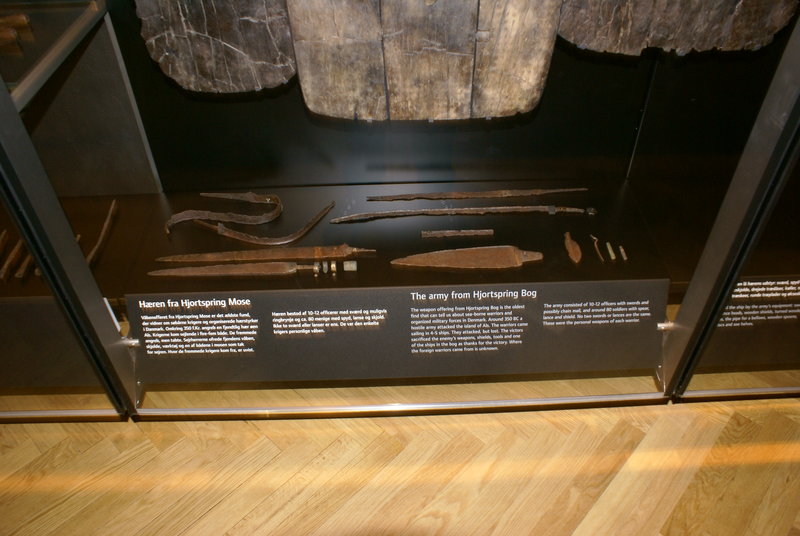
 Attachment: 139.58 KB Attachment: 139.58 KB
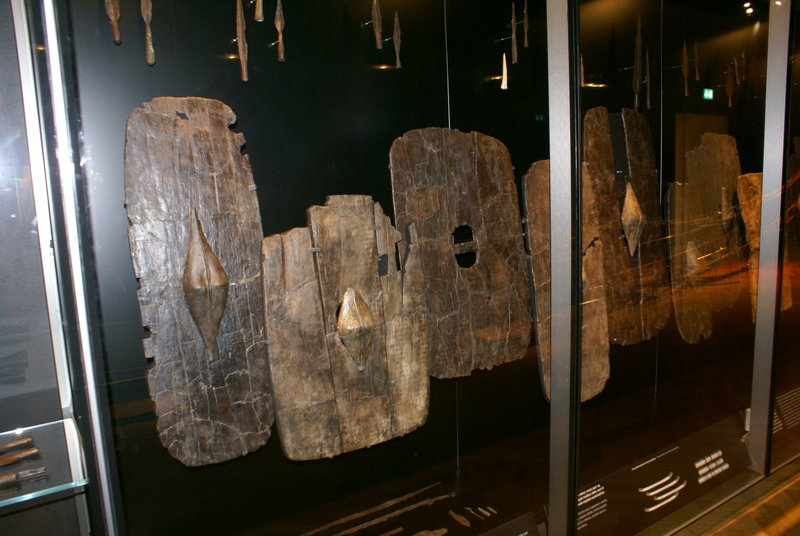
 Attachment: 101.87 KB Attachment: 101.87 KB
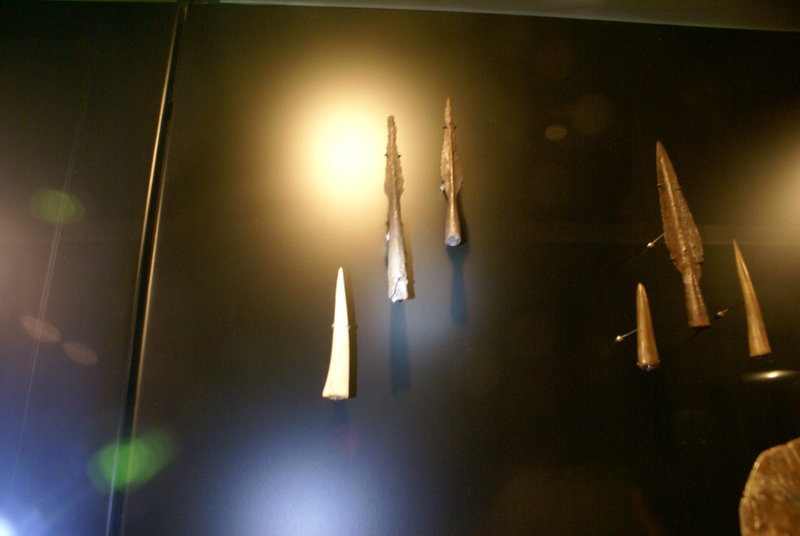
 Attachment: 115.38 KB Attachment: 115.38 KB
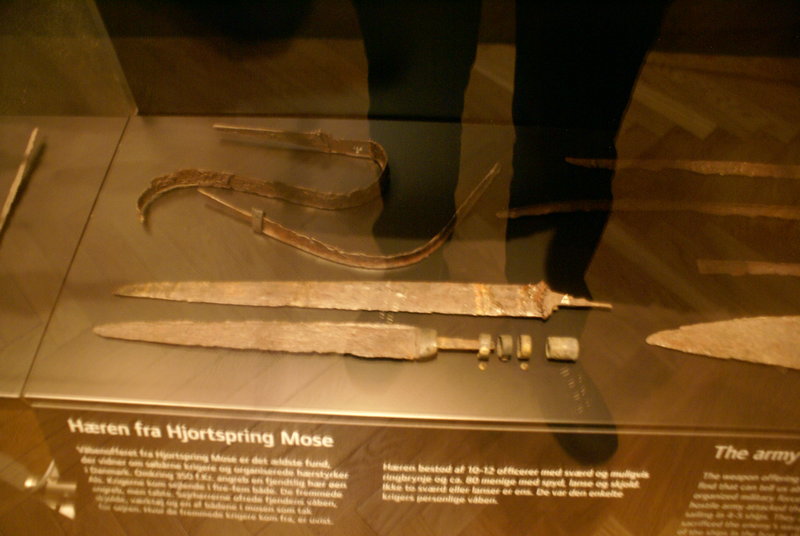
 Attachment: 93.57 KB Attachment: 93.57 KB
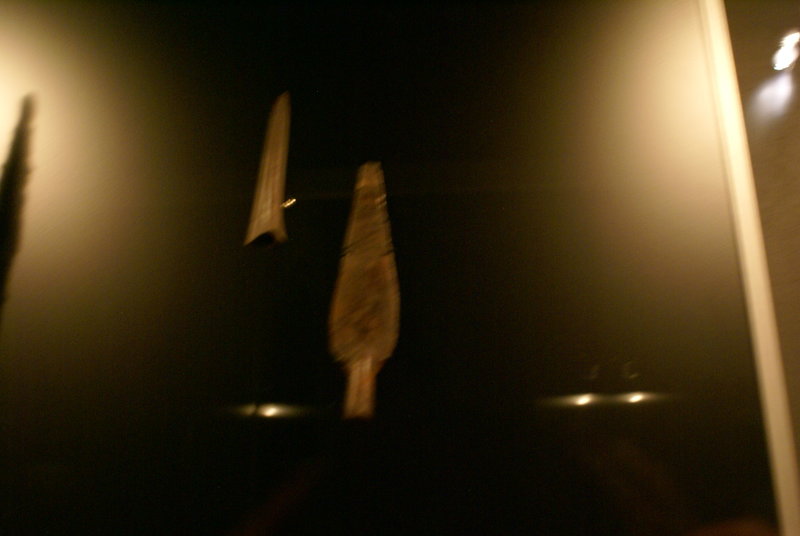
 Attachment: 98.81 KB Attachment: 98.81 KB
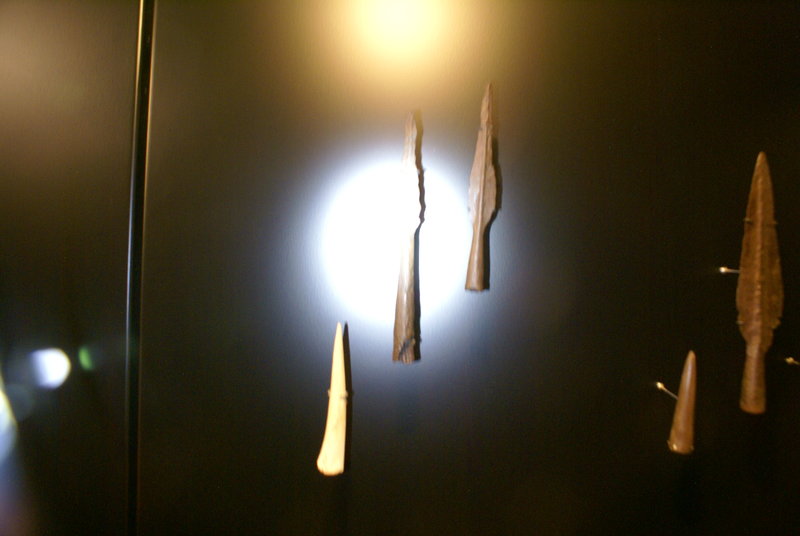
|
|
  |
 |
|
J. Martens
Location: Norway Joined: 06 Jan 2020
Posts: 1
|
|
  |
 |
|
Niels Just Rasmussen
|
|
  |
 |
|
|

